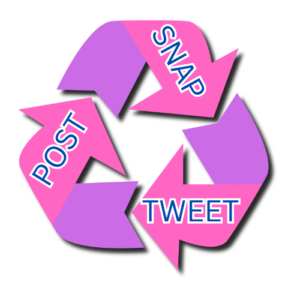
Ah, social media. That delightful place where we can share everything from our breakfast burritos to our existential crises, all while accumulating likes, followers, and the occasional “Did you really post that?” message from Mom. We live in a world where Snapchat streaks and Instagram likes are social currency, but navigating this jungle can sometimes feel like a video game—except the monsters are online predators, and the boss battle is maintaining your sanity. So, how do we survive and thrive in this pixelated paradise?
Buckle up as we dive into the art of mastering digital citizenship while dodging trolls, sextortionists, and the temptation to tweet your every thought. In a previous course, I was able to speak on my personal usage of tech, read it here.
Digital Citizenship: Because Even Your Cat Meme Has Consequences

First things first—digital citizenship isn’t just some boring phrase your teacher throws around to kill your Snap streak. It’s about being a decent human being online and not turning your Facebook feed into a circus of bad decisions. Take it from the unlucky students at Harvard, who thought sharing offensive memes in a “private” group would never come back to bite them. Spoiler alert: It did. Harvard rescinded their admissions faster than you can say “delete.”
Lesson: What you post online has real-world consequences, even if you think you’re just being “funny”.
And don’t think you’re safe just because it’s a “finsta” (finsta – fake instagram). Teens often juggle multiple accounts like a social media ninja—public Instagram for the family, and finsta for “the real stuff.” Just remember, even private accounts aren’t always private. If Harvard taught us anything, it’s that screenshots are forever.
Snap, Crackle, Whoops: The Dangers of Snapchat and Sextortion

Let’s be real—Snapchat may be all about “living in the moment,” but those moments don’t always disappear like we hope. In Canada, an alarming rise in sextortion has made it clear that some moments can stick around like an unwanted house guest. Creeps on the internet are baiting teens into sharing compromising photos, and then—BOOM—they’ve got you cornered. They threaten to send those snaps to all your followers unless you cough up some cash. Yikes!!
Pro tip: If someone asks for nudes on Snapchat, send them a pic of a hairless mole rat instead (yes, that’s a real sextortion prevention campaign—no joke!). Keep your mole rats handy, folks.
Instagram Envy and Twitter Tantrums: It’s All Fun and Games Until You Lose Your Chill

Instagram may have started as a photo-sharing app, but let’s face it—now it’s where we go to flex, filter, and live our best fake lives. And then there’s Twitter, where one wrong tweet can turn into a viral disaster faster than you can say #CancelMe. Combine that with the fact that teens’ brains are basically wired to seek instant gratification (thank you, biology), and it’s easy to see why getting lost in the social media shuffle can lead to some pretty poor decisions (Global News).
If you’re a parent, don’t just turn your kid’s phone into Fort Knox with monitoring apps. Teach them how to adult online. Apps like ReThink—created by a teenager, naturally—help kids pause before they post something dumb. Because sometimes, all we need is a second to think, “Wait, will this make me look like an idiot?” Read more about this here.
FOMO vs. JOMO: The Art of Logging Off (And Why We Secretly Love It)

Here’s where things get interesting. While we’re all obsessed with being connected 24/7, there’s also this trend of glorifying disconnection. The whole “IRL fetish” phenomenon has us bragging about how “off the grid” we are when we keep our phones in our pockets during dinner or manage to survive a day without Facebook. But here’s the kicker: The more we obsess over being offline, the more connected we actually are.
Remember that walk on Cape Cod that Sherry Turkle talks about, where everyone used to look at the ocean and talk to each other instead of staring at their phones? Well, the irony is that those moments of “disconnecting” often end up being the very thing we post about later. So, are we ever really offline? Spoiler: Nope. Not even close.
So, How Do You Navigate This Madness?

It’s simple. Treat social media like you would treat a very public diary. Sure, share the good
times, but also keep a filter on what you’re posting (and no, I don’t mean the Valencia filter).
Being a good digital citizen isn’t just about avoiding drama; it’s about recognizing that the lines between online and offline are blurred, and that your digital actions have real-world consequences.
So next time you’re tempted to post that totally hilarious meme, snap a questionable pic, or engage in a Twitter spat, ask yourself: Is this something I’d want my future boss (or grandma) to see? If not, it might be time to rethink.
What Does This Mean for Teachers?
For teachers, the rise of social media and digital platforms like Snapchat, Twitter, Instagram, and Facebook brings a new set of challenges—and opportunities. With students spending significant portions of their day online, educators are in a unique position to guide them through the maze of digital citizenship, teaching them how to balance the freedom of online expression with the responsibility that comes with it. Here’s what all this means for teachers:
1. Digital Citizenship Isn’t Optional—It’s Essential
Digital citizenship is no longer just a buzzword; it’s a critical part of modern education. Students are navigating online spaces daily, and the stakes are high. Teachers need to foster conversations about online safety, privacy, and the ethics of social media use. It’s not enough to tell students not to post inappropriate content—we need to equip them with the tools to make better decisions and manage risks. This includes:
- Understanding the permanence of online actions: Just like the Harvard students who lost their admissions, students need to grasp that online behavior can have long-term consequences
- Encouraging self-regulation: Apps like ReThink give students a pause button before posting something regrettable. Teachers can integrate discussions about such tools into their digital literacy curriculum
2. Empowering Students to Manage Risks
Instead of focusing solely on restrictions and monitoring, educators can teach students how to manage online risks effectively. Many schools focus on blocking certain websites or enforcing strict social media policies, but this can leave students unprepared for the real-world challenges they’ll face when no one is monitoring their online actions. What’s the alternative?
- Teach problem-solving and impulse control: Give students strategies for handling risky online interactions, such as sextortion and cyberbullying, which are becoming more common.
- Promote critical thinking about online content: Students should be able to recognize manipulative content, phishing scams, and the impact of “like-based” validation on platforms like Instagram and Snapchat.
3. Encourage Open Dialogue About Online Habits
Many students keep their online lives hidden from teachers (and even parents), but creating a safe space for open dialogue can make a big difference. Students may be struggling with sextortion, cyberbullying, or the pressure of managing their digital identity without feeling comfortable seeking help.
Teachers can:
- Incorporate discussions on online behavior into daily lessons, linking them to real-world consequences.
- Model good digital citizenship themselves by discussing their own use of social media responsibly.
- Facilitate media literacy workshops to educate both students and parents on navigating social media and understanding its influence on mental health and social relationships.
4. Integrate Digital Citizenship Across the Curriculum
Digital citizenship shouldn’t just be a one-off lesson; it should be integrated into multiple aspects of the curriculum. Whether you’re teaching English, history, or science, there are countless opportunities to address how students interact with and present themselves online.
Examples include:
- Analyzing social media trends and how they reflect society’s values in history or sociology classes.
- Creating projects where students engage critically with social media platforms, learning about the ethical implications of their digital actions
5. Addressing the Digital Divide
Teachers should also be aware that not all students have equal access to technology. The digital divide can affect how students engage with digital citizenship lessons. Some students may have constant access to the latest smartphones and apps, while others may only get online at school. Being mindful of these disparities allows teachers to create inclusive strategies that ensure all students develop essential digital skills.
6. Professional Development for Teachers
Just as students need digital literacy, so do teachers. Schools should provide ongoing professional development for educators, ensuring they are up-to-date with the latest trends, apps, and risks associated with Snapchat, Instagram, Twitter, and other platforms. Teachers should be prepared to address students’ digital behavior as part of their role as educators.
Final Thoughts: Teaching Digital Citizenship in the Age of Social Media
Ultimately, the goal for teachers is to help students not only survive but thrive in the digital world. That means creating a learning environment where students feel empowered to make informed, ethical, and responsible decisions online. As educators, our role is to guide students through the blurred lines between their online and offline lives, ensuring that they understand the power—and responsibility—that comes with digital freedom.
Incorporating digital citizenship into daily education helps students become more conscious of their actions, fostering safer and healthier online communities. And who knows? Maybe the next time they go to post a mole rat meme, they’ll think twice—and thank you for it.
